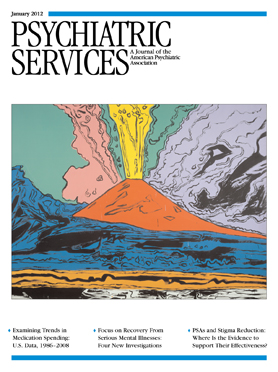Using Telemedicine to Coordinate Inpatient and Outpatient Psychiatric Care
Strong Ties Community Support Program is a community mental health center affiliated with the University of Rochester that provides outpatient psychiatric treatment to individuals in the community of Rochester, New York. Strong Ties serves approximately 1,500 outpatients, with an average of 11–12 individuals requiring inpatient psychiatric hospitalization at the University of Rochester Medical Center at any time. Our inpatient service uses a hospitalist model, with five inpatient psychiatrists covering a total of 54 hospital beds. Because inpatient care for hospitalized Strong Ties patients is provided by psychiatrists different from providers of their outpatient care, regular communication between the inpatient and outpatient treatment teams is necessary. However, such communication is sometimes difficult to achieve because of conflicting schedules and because the inpatient service is located approximately two miles from Strong Ties (a distance that seems much longer during Rochester's snowy winter days).
To improve communication, a weekly teleconference was implemented via a Web conferencing system in February 2010. Every Thursday at 12:30 p.m., the inpatient and outpatient teams meet to discuss clinical concerns related to Strong Ties inpatients. At the hospital, inpatient team attendees include the attending psychiatrist, psychiatry residents, medical students, nurse practitioners, and social workers. Clinicians present at the Strong Ties location include psychiatrists, nurse practitioners, therapists, and case managers. This meeting usually lasts about 30 minutes, but the duration varies depending on the number of patients and the complexity of their cases. Initially it was peculiar speaking to a video monitor instead of face to face, but the monitor quickly seemed to disappear and we became one large team of clinicians working collectively to provide effective care for our most acute patients.
After several months of holding this weekly teleconference, we have discovered numerous benefits that have led to improvements in patient care. We are now better able to discuss our patients' progress on the inpatient unit and share information about successful and unsuccessful past medications trials, housing options, family concerns, legal issues, and available supports. Planning for discharge has been streamlined; the outpatient clinician readily can confirm with the inpatient team when follow-up will take place. Resident physicians also have found this meeting to be educational in that they have more contact with the outpatient attending psychiatrists and can gain a broader perspective on how comprehensive care is provided.
Communicating via a Web conferencing system is clearly superior to e-mail, because there is no opportunity for misinterpretation of written information. In addition, teleconferencing allows large groups of people to communicate concurrently. We have also found that patients and their families are pleased to hear about our new form of communication.
Although this is undoubtedly a step forward in collaboration between outpatient and inpatient teams, there remainsroom for improvement. Occasional technical difficulties arise but are quickly rectified by our technical support service. Coordination of schedules remains difficult, and it is often a challenge to have all necessary clinicians present at the weekly teleconference. In addition, the need to share information often cannot wait until the scheduled meeting time. In the future we hope to be able to schedule spontaneous meetings to address acute concerns. A brief, five-minute conference often can produce greater results than multiple days of e-mails and telephone calls.
In general, we find that the addition of our weekly teleconference is an improvement in communication and collaboration that has resulted in enhanced patient care. Further development will be needed in order to integrate this novel approach into daily clinical operations.



